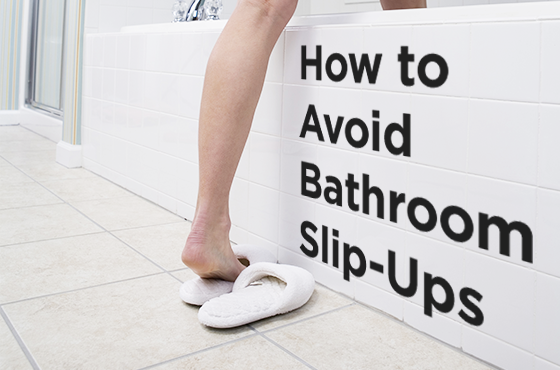How to Avoid Bathroom Slip-Ups

Has injury or illness led to difficulty accessing a bathroom at home? Since the bathroom is one of the most common places for falls and injury, safety and function are top priorities when considering access-related bathroom redesigns.
An occupational therapist can play a key role in finding creative solutions for overcoming bathroom barriers at home by evaluating the situation with a holistic perspective. Their recommendations are based on the mental and physical abilities of the person while also considering his/her financial resources. In addition, an occupational therapist has an in-depth understanding of the accessible bathroom design guidelines outlined in the Americans with Disability Act.
Design review includes wheelchair access through the door and around to the toilet, toilet height, sink height, ease of turning sink handles, and shower accessibility. Often, older homes cannot accommodate a wheelchair, so a bedside commode might be a good temporary solution until the bathroom can be renovated. If the commode is too low, a riser can be used or the toilet can be replaced with a handicap-height toilet. If getting clean after toileting is hard, a bidet seat washlet attachment may be helpful. Bath or shower access is also observed by the therapist to determine faucet access and if a seat or tub bench is easier. Grab bars are fundamental accessories, so the therapist determines the best placement based on wall space and the patient’s strength.
After the needs are determined, it’s time to install the solutions. Local plumbing and/or medical supply companies can assist and usually have showrooms to test the products and equipment options in every budget. Bathroom modifications can range from installing a grab bar all the way to a full bathroom renovation. It’s important that the plumber and/or contractor understand the homeowner’s needs to ensure the equipment can be used safely once it is installed.
A bathroom designed without function and safety in mind is a slip-up any homeowner can avoid. To understand how an occupational therapist can help you, a family member, or a patient function better in everyday life, call (877) 56-REHAB or visit the Sheltering Arms Occupational Therapy website.
Resources:
Home Modifications and Occupational Therapy © American Occupational Therapy Association, 2016
2010 ADA Standards for Accessible Design © Department of Justice, 2010